Below is a slightly reformatted version of the comments I submitted in response to the Florida Keys National Wildlife Refuges Complex Integrated Predator Management Plan/Draft Environmental Assessment. A PDF version is available here.
• • •
To Whom It May Concern:
I am writing to comment on the Florida Keys National Wildlife Refuges Complex Integrated Predator Management Plan/Draft Environmental Assessment. As I point out below, the IPMP/EA proposed by FWS fails to adequately address—or overlooks entirely—several key issues. Only now, for example—after years of struggling with this issue—does FWS propose to “implement monitoring and conduct further research as needed to determine abundance and distribution of free-roaming cats throughout the Refuge, document effectiveness of management actions taken or not taken on cat populations, and determine the impacts on the ecosystems and native species to aid in the adaptive management process.” [1]
How can FWS even put forward its IPMP/EA without this critical information in hand? One would expect, under the circumstances, that population estimates and scat analysis, for instance—along with whatever additional research might better inform any proposed action by FWS—would form the basis of such an IPMP/EA.
In addition, the IPMP/EA fails to address risks inherent with the improper management of free-roaming cats in the Keys. The plan proposed by FWS is unlikely to result in the removal of cats at a rate sufficient to keep pace with reproduction—a situation exacerbated greatly by its insistence on banning the feeding of feral cats and Trap-Neuter-Return (TNR) programs. Consequently, the population of feral cats may very well increase. And even if FWS is successful at removing cats from some locations, the IPMP/EA fails to take into account the risk of mesopredator release—the inevitable spike in non-native rodent populations—and its impact on the native species the IPMP/EA aims to protect.
For these reasons (each of which is outlined in detail below), I strongly encourage FWS to revise its IPMP/EA, especially as it pertains to the removal of feral cats.
Justification for Action
After a thorough reading of the Draft Environmental Assessment (EA) for the Florida Keys National Wildlife Refuges Complex (FKNWRC) Integrated Predator Management Plan—along with several supporting documents (as described below)—I am struck by how inadequately the IPMP/EA addresses several critical issues. Indeed, the Plan’s Justification for Management Action suggests that FWS has an insufficient and/or largely incorrect understanding of the impacts of feral and free-roaming cats on native wildlife and the environment.
Extinctions
Among the studies FWS cites to support its claim that “free-roaming cats have been shown to be a major cause of 33 native species extinction globally,” [1] is a 1987 paper by Cruz and Cruz, in which the authors, studying Galápagos Petrels, found that cats were hardly the only culprits:
“They are threatened by introduced rats, which attack eggs and young chicks… dogs and pigs which prey on eggs, nestlings and adults. Introduced goats, burros and cattle destroy nesting habitat and trample nests. A different combination of these pests and predators exists at each of the petrel nesting sites, while three of the islands are plagued by all of them.” [2]
The FWS would have the public believe the Galápagos Petrel is among those 33 extinctions. In fact, the birds are still there, though they are listed as Critically Endangered.
The story is similar for the 1986 paper by Kirkpatrick and Rauzon, another purported link between free-roaming cats and species extinctions. In fact, Kirkpatrick and Rauzon found that more than 90 percent of the diet of free-roaming cats on Jarvis Island and Howland Island was made up of Sooty Terns, Wedge-tailed Shearwaters, and Brown Noddies—each of which is listed as a species of Least Concern. [3]
Another of the papers cited by FWS has nothing to do with extinctions at all. As the authors describe it, their study was an evaluation of “whether a collar-worn pounce protector, the CatBib, reduces the number of vertebrates caught by pet cats and whether its effectiveness was influenced by colour or adding a bell.” [4]
Also listed among the “evidence” of island extinctions were studies that—in addition to having nothing to do with extinctions—were not conducted on islands. Coleman and Temple’s 1993 survey, for example, involved rural Wisconsin residents and their outdoor cats, [5] while Churcher and Lawton surveyed residents of a small English village. [6]
Threatened or Endangered Species
FWS’s assertion that “many of the species impacted by free-roaming cats are federally listed threatened or endangered species and federally protected migratory birds” [1] is, while probably true, also largely meaningless. According to the 2009 State of the Birds report, published by the Department of the Interior:
“The United States is home to a tremendous diversity of native birds, with more than 800 species inhabiting terrestrial, coastal, and ocean habitats, including Hawaii. Among these species, 67 are federally listed as endangered or threatened. An additional 184 are species of conservation concern because of their small distribution, high threats, or declining populations.” [7]
That translates to approximately 31 percent of all birds in this country being species of concern. FWS makes it sound as if perhaps the cats are targeting these birds; in fact, it’s obvious that all forms of mortality pose an acute threat to these vulnerable populations.
Disruptions to Native Ecosystems
When it comes to the disruption caused by cats to “the abundance, diversity, and integrity of native ecosystems,” FWS turns to, among others, studies by Hawkins [8] and Jessup. [9]
But Hawkins’ dissertation work is plagued with problems that raise serious doubts about his rather triumphant conclusions—“the preference of ground feeding birds for the no-cat treatment was striking,” [8] for example. A closer look reveals that five of the nine ground-feeding birds in his study showed no preference for either area of the study site (a fact Hawkins downplays considerably). Without any explanation for why these vulnerable bird species were indifferent to the presence of an opportunistic predator, Hawkins is in no position to make the causal connections he does.
Jessup cites some well-known predation studies, but his concern is not the (presumed) impact on wildlife, per se, but rather the wholesale condemnation of “trap, neuter, and reabandon,” [9] as he calls it.
Birds and Cats
FWS claims that “free-roaming cats kill at least one billion birds every year in the U.S., representing one of the largest single sources of human-influenced mortality for small native wildlife,” [1] supporting the assertion with just three sources, one of which is Rich Stallcup’s 1991 article from the Observer, a publication of the Point Reyes Bird Observatory. But “A Reversible Catastrophe” is very light on science—and, frankly, Stallcup gets most of that wrong. Mainly, the article is Stallcup’s manifesto regarding neighborhood cats:
“If you have a garden, why not proclaim it a wildlife sanctuary and protect it from non-native predators? If roaming cats come into your sanctuary to poach the wildlife under your stewardship, you have the right and perhaps even the duty to discourage them in a serious way.” [10]
Stallcup goes on to suggest that gardeners “…try a B-B or pellet gun. There is no need to kill or shoot toward the head, but a good sting on the rump seems memorable for most felines, and they seldom return for a third experience.” [10]
Another of the studies cited by FWS—a 2008 paper by Sax and Gaines—isn’t about cats at all. Or even invasive animals. Although the authors do mention “the extinction of many native animal species on islands” [11] briefly in their introduction, the purpose of the paper is, as the authors state plainly enough, to “show that the number of naturalized plant species has increased linearly over time on many individual islands.” [11, emphasis mine]
Nevertheless, the assertion—made by FWS and many others, too—that “cats kill at least one billion birds every year in the U.S.” deserves careful scrutiny. Such aggregate figures can typically be traced to small—often flawed—studies, the results of which are subsequently extrapolated from one habitat to another, conflating island populations with those on continents, combining common and rare bird species, and so forth. Perhaps the most famous example of such pseudoscientific manipulation is the infamous “Wisconsin Study” by Coleman and Temple.
Actually, there was no Wisconsin Study, in the scientific, peer-reviewed-publication sense. The often-cited “estimates”—which have, over the past 15 years, taken on mythical status—were nothing more than back-of-the envelopes guesses. Indeed, co-author Stanley Temple himself admitted that their figures weren’t “actual data,” though many—including the FWS—continue treating these figures as if they were actual data. “That was just our projection to show how bad it might be,” noted Temple. [12]
But Temple wasn’t as forthright about was the origin of their “estimates.” The authors’ “intermediate” figure of “38.7 million birds killed by rural cats” [13] is based on the results of a study involving just four “urban” cats and one rural cat in Virginia [14, 15] (this, in addition to Coleman and Temple’s several flawed assumptions). And their high estimate was even less valid.
Something else often left out of the debate: predation—even at high levels—does not automatically lead to population declines. In fact, some studies [16, 17] have shown that birds killed by cats are, on average, significantly less healthy than those killed through non-predatory events (e.g., collisions with buildings).
In the end, enormous “estimates” of annual predation rates are utterly meaningless—useful only as a sensational talking point by organizations interested in vilifying free-roaming cats. Such figures are routinely “sold” to a mainstream media and public unfamiliar with the larger context.
Threats to Public Health
Citing the Centers for Disease Control website, FWS argues:
“…free-roaming cats not only threaten wildlife through direct predation but also serve as vectors for a number of diseases including rabies, cat scratch fever, hookworms, roundworms and toxoplasmosis. Some of these diseases can be transmitted to other domestic animals, native wildlife, and in some cases, humans.” [1]
In fact, the CDC site makes no mention of cats being a threat to wildlife. And humans? “Although cats can carry diseases and pass them to people, you are not likely to get sick from touching or owning a cat.” And, notes the CDC, “People are probably more likely to get toxoplasmosis from gardening or eating raw meat than from having a pet cat.”
There’s even a link to another page on the CDC’s site, called “Health Benefits of Pets.”
False Premises
The numerous misrepresentations, oversights, and errors outlined above suggest quite clearly that FWS either lacks a sufficient grasp of the critical issues involved—or that it’s not interested in being forthright with the public. This is not an academic issue; nor should my detailed criticism be considered nitpicking. After all, it’s quite clear that FWS intends to eliminate free-roaming cats on public—and, if possible, also private—land throughout the Keys. As “justification for action,” the IPMP/EA falls well short of what is required; as a public record, it is wholly unacceptable—and, to be very candid about it—an embarrassment to the agency and the people involved. Simply put, any subsequent action taken by FWS on the basis of this IPMP/EA can, I think, rightfully be considered unjustified.
Moreover, in its attempt to focus on the impacts of cats, FWS overlooks some key factors. As a result, implementation of the IPMP/EA may very well increase the threat to the Keys’ native wildlife.
Mesopredator Release
In its IPMP/EA, FWS refers to two often-cited papers [18, 19] as evidence of cats disrupting native ecosystems, but fails to acknowledge the larger point made by the authors: the mesopredator release phenomenon. “In the absence of large, dominant predators,” write Soulé et al., “smaller omnivores and predators undergo population explosions, sometimes becoming four to 10 times more abundant than normal.” [18]
For Soulé et al., coyotes were the dominant predators, while cats were the mesopredators. In other contexts, however, cats have been shown to play the dominant predator role with non-native rats becoming the mesopredators. [20–23].
Mathematical modeling of the mesopredator release phenomenon illustrates the complexities involved in eradication efforts, even on small islands. As Courchamp et al. explain, “although counter-intuitive, eradication of introduced superpredators, such as feral domestic cats, is not always the best solution to protect endemic prey when introduced mesopredators, such as rats, are also present.” [22] Fan et al. warn of the risks involved with such eradication efforts: “In some cases, it may cause a disastrous impact to managed or natural ecosystems.” [21]
Macquarie Island, located roughly halfway between New Zealand and Antarctica, offers a well-documented example of such a disastrous impact. In 2000, cats were eradicated from this United Nations Educational, Scientific and Cultural Organization World Heritage Site in order to protect its seabird populations. The resulting rebound in rabbit and rodent numbers, however, has had its own disastrous impact. “In response, Federal and State governments in Australia have committed AU$24 million for an integrated rabbit, rat and mouse eradication programme.” [23]
Mesopredator Release in the Keys
But FWS doesn’t even mention the risk of mesopredator release in its IPMP/EA, despite the fact that—should the population of free-roaming cats be sufficiently reduced—the situation in the Keys suggests that such an outcome is actually quite likely. (Because the population and diet of these cats is poorly understood in the Keys, the degree of reduction that would trigger a mesopredator release, too, is unknown.)
According to FWS, non-native rats are already “prevalent in residential and commercial areas.” [1] Should the removal of cats create a spike in their numbers, FWS suggests that they’re prepared to remove the rats, too: “Noticeable population increases based on reports, road kill, or other specific or auxiliary data may initiate targeted control and eradication efforts in addition to incidental capture…” [1]
But controlling these rats is complicated considerably by the need to protect Lower Keys marsh rabbits. The South Florida Multi-Species Recovery Plan (MSRP) warns of these rabbits coming into contact with pesticides and “poisons used to control black rats.” [24]
“In a 1993 Biological Opinion, the FWS investigated the effects of vertebrate control agents on endangered and threatened species and determined that several chemicals (e.g., Pival) would jeopardize the continued existence of the Lower Keys marsh rabbit. Chemicals—such as Pival—a rodenticide used to kill rats, are lethal if ingested. The FWS also concluded that if development in the Keys continues to increase, the potential for these animals to come in contact with such chemicals also increases, as does the potential for their extinction. Based on these findings, the FWS believes the continued use of such chemicals will result in the deaths of Lower Keys marsh rabbits. Given that the majority of occupied habitat is adjacent to urbanized areas, and that urbanization continues to expand into their habitat, then it can reasonably be predicted that the use of such chemicals has had a negative impact upon the Lower Keys marsh rabbit that may prevent its recovery.” [24]
Again, there’s no consideration whatsoever in the IPMP/EA for how the Lower Keys marsh rabbits—the protection of which was a key factor in the creation of the IPMP/EA in the first place—will be protected from increased predatory pressure by non-native rats. Yet, based on the evidence presented by FWS, it’s quite clear that the elimination of free-roaming cats in the Keys will very likely have a negative impact on their numbers—and may very well lead to the extirpation of marsh rabbits from any Key where these rats are present.
The same may be true of the Key Largo cotton mouse [25, 26], Key Largo woodrat [27, 28], and silver rice rat [29, 30], all of which are identified as species of particular concern in the IPMP/EA, and which are threatened—either through predation or competition—by non-native rats such as the black rat.
Alternatives
According to FWS, “the Proposed Action is a fully integrated range of nonlethal and lethal predator management strategies that would be available for implementation on the FKNWRC, depending on the status, distribution, and extent of predation by targeted predator species.” [1] Where feral cats are concerned, however, the “Proposed Action” is nothing more than the “traditional” trap-and-kill approach—this, despite the fact that FWS lacks sufficient data concerning the distribution of, and extent of predation by, feral cats.
FWS is less than forthright on this point, however. According to the IPMP/EA:
“The Monroe County animal control service provider will have the authority to determine the final disposition of the trapped cats according to county ordinances and standards, which may include returning to owner, adopting out, relocating to a long-term cat care facility on the mainland, or euthanizing.” [1]
It’s no secret what happens to nearly every feral cat brought into shelters. As Nathan Winograd writes in his book Redemption: The Myth of Pet Overpopulation and the No Kill Revolution in America, “there is no other animal entering a shelter whose prospects are so grim and outcome so certain.” [31]
I asked Connie Christian, Executive Director of the Florida Keys SPCA about this last month. “Every cat brought to our facility is assessed to determine their disposition,” Christian told me via e-mail. “Every attempt is made to return ‘non-feral’ cats to their owners or place for adoption.”
“Unfortunately,” she continued, “we do not have an outlet for feral cats that are brought to us without a request for return.” Which would likely be the case for cats unlucky enough to be trapped by FWS.
(As I understand it, there was a no-kill shelter available at the time of the stakeholder meetings, thus buy-in from those concerned for the welfare of these cats. However, as this is no longer the case (again, this is my understanding of the situation), FWS cannot assume that the same level of buy-in exists today. And in any case, the suggestion of a no-kill shelter or sanctuary as a solution to the Keys’ feral cat issue is at best disingenuous.)
Removing Cats
Setting aside for the moment the issues mentioned above, the IPMP/EA offers little to suggest that FWS will actually be able to remove the free-roaming cats from the Keys. The fact that the agency has no idea how many cats there are is only the beginning. Reports indicate that FWS has a rather poor track record when it comes to trapping cats. Its 2003 contract with USDA, for example, yielded just 23 cats over 31 days of trapping. [32]
In 2007, FWS “received $50,000 to remove cats from federal refuges on Big Pine Key and Key Largo, and to protect endangered marsh rabbits, silver rice rats and other animals and birds that call the refuges home.” [33] Unofficial reports (I’m told nothing official has been issued yet) suggest that fewer than 20 cats were caught—some of which were clearly not feral—along with 81 raccoons, 53 of which were released alive. [34]
I think it’s safe to say that the Keys’ wildlife reaped little or no benefit from either effort. Had the 2007 funding been used for TNR, on the other hand, the impact could have been substantial.
Eradication Efforts
As I’m sure FWS is aware, numerous eradication efforts—the horrors of which are spelled out in some of the papers cited in the IPMP/EA—have been used to successfully remove cats from islands:
- Nogales et al., describing the “success” of Marion Island, note, “it took about 15 years of intense effort to eradicate the cats, combining several methods such as trapping, hunting, poisoning, and disease introduction… The use of disease agents or targeted poisoning campaigns hold promise for an initial population reduction in eradication programs on large islands—such an approach may save effort, time, and money.” [35]
- Cruz and Cruz point out that, of all the non-native mammals there, cats were “the most difficult to control or eliminate on Floreana Island.” Although “hunting with dogs was the single most effective method employed and it gave a sure body count,” the authors warn that “the method was costly and with the limited manpower available was only useful over small areas. Both poisoning and trapping were effective and the combination of the three methods is probably the most effective approach, as well as being the best use of time and materials.” [2]
- Veitch describes efforts on 11-square-mile Little Barrier Island as “a determined [cat] eradication attempt” involving “cage traps, leg-hold traps, dogs and 1080 poison were used, but leg-hold traps and 1080 poison were the only effective methods.” [35] Four cats were also infected with Feline enteritis, but “because of the poor reaction to the virus no other cats were dosed and none were released… Altogether, 151 cats were known to have been killed before the eradication was declared complete. Important lessons learnt can be transferred to other feral cat eradication programmes.” [36] (By way of comparison, the Keys are approximately 137 square miles in total area.)
As FWS notes in its IPMP/EA, such methods are “not… socially acceptable” and “inconsistent with the points of consensus developed by the stakeholder group.” While I agree completely that these methods are unacceptable, the “fully integrated range of nonlethal and lethal predator management strategies” proposed by FWS strike me as nothing more than business as usual. How will this be any different (other than perhaps in terms of scale) than the failed efforts of the past?
If implemented as-planned, it seems clear that FWS will not be able to remove the cats quickly enough to keep up with reproduction rates. Using a population model, Andersen, Martin, and Roemer have suggested that, in the absence of a sterilization program, 50 percent of cats would have to be removed in order for a colony to decrease 10 percent annually. [37] This model has its flaws (some of which are described in “Reassessment”) but even if Andersen et al. are off by a factor of two, FWS would need to remove 25 percent of the free-roaming, unsterilized (and in the absence of TNR, it won’t be long before that’s the norm) cats continuously in order to achieve a modest 10 percent annual reduction in overall numbers.
Does anybody at FWS really think that’s going to happen? Where’s the evidence to suggest that it’s even possible?
If the feeding of feral cats and TNR are eliminated (to whatever extent possible) throughout the Keys, these cats will simply “go underground.” That means no more monitoring—and sterilizing—by the “foot soldiers” who currently care for them.
Indeed, it’s quite likely that feral cat complaint calls to Monroe County, FWS, and USDA would taper off considerably, as it becomes clear that such a call is essentially a death sentence. Thus, the cats would become that much more difficult to locate—and sterilize. The population, therefore, would increase—probably very quickly.
In other words, the most likely outcome of the IPMP/EA put forward by FWS is an increase in the number of feral cats in the Keys—and, of course, a corresponding increase in the negative impacts they have on the area’s wildlife and environment.
Trap-Neuter-Return
In contrast to the IPMP/EA—with its risk of mesopredator release, on the one hand, and potential to inadvertently drive up the numbers of feral cats, on the other—TNR offers the potential to more carefully manage the population of feral cats in the Keys. Indeed, given the precarious nature of wildlife in the Keys, TNR may actually be the best approach to fulfill the purpose of the IPMP/EA:
“…conserve and restore federally-listed species and protect all native fauna and flora on the [refuges] from population decline and potential extirpation or extinction due to predation by non-native species and human-subsidized populations of native predators.” [1]
The fact that TNR was “considered but dismissed from further evaluation,” again, suggests that FWS failed to adequately analyze all of the available predator management alternatives. And, similar to its “justification for action,” FWS’s rationale for dismissing TNR doesn’t hold up to scrutiny.
FWS argues, for example, that TNR “does little to reduce cat predation on native wildlife.” Although few predation studies have examined the hunting behavior of cats belonging to managed colonies, those that have are revealing. Reporting on their study of free-roaming cats in Brooklyn, Calhoon and Haspel write: “Although birds and small rodents are plentiful in the study area, only once in more than 180 [hours] of observations did we observe predation.” [38]
And Castillo and Clarke (though highly critical of TNR) actually documented remarkably little predation in the two Florida parks they used for their study. In fact, over the course of approximately 300 hours of observation (this, in addition to “several months identifying, describing, and photographing each of the cats living in the colonies” [39] prior to beginning their research), Castillo and Clarke “saw cats kill a juvenile common yellowthroat and a blue jay. Cats also caught and ate green anoles, bark anoles, and brown anoles. In addition, we found the carcasses of a gray catbird and a juvenile opossum in the feeding area.” [39]
“In addition,” argues FWS, “the TNR method has little valid scientific support for claims that it actually reduces cat colony numbers over time and often has been shown to attract people to release new cats into an area.” [1] Ironically, some of the greatest TNR success stories are right there in the papers cited by FWS. Natoli, for example, reported a 16–32 percent decrease in population size over a 10-year period across 103 colonies in Rome—despite a 21 percent rate of “cat immigration.” [40] And, as of 2004, ORCAT, run by the Ocean Reef Community Association, had reduced its “overall population from approximately 2,000 cats to 500 cats.” [41] According to the ORCAT website, the population today is approximately 350, of which only about 250 are free-roaming.
Any TNR program contends with the unfortunate (and illegal) dumping of cats. Still, it’s difficult to imagine that the presence or absence of a nearby TNR program would affect a person’s decision to abandon his/her pet cat(s). (If any studies had demonstrated such a connection, TNR opponents would surely cite them.) On the other hand, cats dumped near a managed colony are far more likely to be adopted and/or sterilized—thereby mitigating their potential impact on the overall population of unowned cats—as well any impacts to wildlife and the environment.
Moreover, FWS ignores the value of population stabilization. Julie Levy, Maddie’s Professor of Shelter Medicine in the University of Florida’s College of Veterinary Medicine, and one of the country’s foremost experts on feral cats, argues that “wildlife benefits when populations of cats that are trending rapidly upwards are at least stabilized.” [42] Nothing in the IPMP/EA suggests that such stabilization will be achieved in the Keys.
ESA and MBTA
Among the more perplexing aspects of FWS’s argument is their claim that “TNR practices are prohibited on National Wildlife Refuges, and violate the Endangered Species Act (ESA) and the Migratory Bird Treaty Act (MBTA) because they may result in the direct harm of protected species.”
This is an argument that’s been thrown around since at least 2003, when Pamela Jo Hatley, then a law student, suggested the possibility. But that’s all it was—and, apparently, is—a possibility.
“It is quite obvious that cats can be lethal to birds,” writes Hatley, “and if the death of a migratory bird can be traced to a cat, or a cat colony, which can be further traced to an individual or organization, there may be strict liability for that person under the MBTA.” [43] Hatley’s argument for violations of the Endangered Species Act is similarly speculative: “…persons who release cats into the wild or who maintain feral cat colonies could be found liable for a take under section 9 of the ESA if maintenance of feral cats in the wild is found to kill or injure wildlife by degrading habitat.” [43]
It’s been nearly eight years now—a period during which TNR has undoubtedly increased substantially across the country—so where are all the court cases? If this were as black-and-white as FWS makes it sound, there wouldn’t even be a discussion about TNR (and the Urban Wildlands Group would likely have taken a very different tack in its opposition to TNR in Los Angeles).
Summary
There is no doubt that the Florida Keys are immensely valuable for their diversity of animal and plant life, some of which can be found nowhere else in the world. Due to a wide range of factors—most of them human-caused—this habitat has become quite fragile, with some animal and plant species on the brink of extinction. Ecosystems—especially those as fragile as the Keys—are incomprehensibly complex, and tinkering with them is incredibly risky. And there’s plenty we simply do not know, and cannot—despite our best efforts—predict.
In its attempt to eliminate free-roaming cats from the Keys, FWS overlooks several important factors, thereby imposing a greater risk to the very native wildlife it aims to protect.
The IPMP/EA proposed by FWS fails to adequately address (1) the presumed impacts of free-roaming cats on native wildlife in the Keys, and (2) the risks inherent with the improper management of these cats. It’s easy to imagine the losers in the deal—the cats, obviously, but also all of the wildlife FWS wants to protect. And the taxpayers, too, of course—this promises to be a dismal return on investment for all of us, no matter what our position might be on feral cats, wildlife conservation, and the like. The question is, where are the winners?
I strongly encourage FWS to revise its IPMP/EA, paying particular attention to these two issues, and to give further consideration to TNR in light of these and other important factors outlined in this letter.
Respectfully,
Peter J. Wolf
Independent Researcher/Analyst
www.VoxFelina.com
Literature Cited
1. n.a., Draft Environmental Assessment: Florida Keys National Wildlife Refuges Complex Integrated Predator Management Plan. 2011, U.S. Fish & Wildlife Service: Big Pine Key, FL. http://www.fws.gov/nationalkeydeer/predatormgmt.html
http://www.fws.gov/nationalkeydeer/pdfs/USFWS%20FL%20Keys%20Refuges%20Integrated%20Predator%20Mgmt%20Plan%20&%20EA%20FINAL%20DRAFT.pdf
2. Cruz, J.B. and Cruz, F., “Conservation of the dark-rumped petrel Pterodroma phaeopygia in the Galápagos Islands, Ecuador.” Biological Conservation. 1987. 42(4): p. 303-311. http://www.sciencedirect.com/science/article/B6V5X-48XKMBP-17J/2/f81b57e317f217802d9aca8b6927a88c
3. Kirkpatrick, R.D. and Rauzon, M.J., “Foods of Feral Cats Felis catus on Jarvis and Howland Islands, Central Pacific Ocean.” Biotropica. 1986. 18(1): p. 72-75. http://www.jstor.org/stable/2388365
4. Calver, M., et al., “Reducing the rate of predation on wildlife by pet cats: The efficacy and practicability of collar-mounted pounce protectors.” Biological Conservation. 2007. 137(3): p. 341-348. http://www.sciencedirect.com/science/article/B6V5X-4NGBB7H-3/2/456180347a2c3916d1ae99e220dd329e
5. Coleman, J.S. and Temple, S.A., “Rural Residents’ Free-Ranging Domestic Cats: A Survey.”Wildlife Society Bulletin. 1993. 21(4): p. 381–390. http://www.jstor.org/pss/3783408
6. Churcher, P.B. and Lawton, J.H., “Predation by domestic cats in an English village.” Journal of Zoology. 1987. 212(3): p. 439-455. http://dx.doi.org/10.1111/j.1469-7998.1987.tb02915.x
7. n.a., State of the Birds, United States of America, 2009. 2009, U.S. Department of Interior: Washington, DC. p. 36. http://www.stateofthebirds.org/
www.stateofthebirds.org/pdf_files/State_of_the_Birds_2009.pdf
8. Hawkins, C.C., Impact of a subsidized exotic predator on native biota: Effect of house cats (Felis catus) on California birds and rodents. 1998, Texas A&M University
9. Jessup, D.A., “The welfare of feral cats and wildlife.” Journal of the American Veterinary Medical Association. 2004. 225(9): p. 1377-1383. http://www.ncbi.nlm.nih.gov/pubmed/15552312
http://www.avma.org/avmacollections/feral_cats/javma_225_9_1377.pdf
10. Stallcup, R., “A reversible catastrophe.” Observer 91. 1991(Spring/Summer): p. 8–9. http://www.prbo.org/cms/print.php?mid=530
http://www.prbo.org/cms/docs/observer/focus/focus29cats1991.pdf
11. Sax, D.F. and Gaines, S.D., Species invasions and extinction: The future of native biodiversity on islands, in In the Light of Evolution II: Biodiversity and Extinction,. 2008: Irvine, CA. p. 11490–11497. www.pnas.org/content/105/suppl.1/11490.full
http://www.pnas.org/content/105/suppl.1/11490.full.pdf
12. Elliott, J. (1994, March 3–16). The Accused. The Sonoma County Independent, pp. 1, 10.
13. Coleman, J.S. and Temple, S.A., On the Prowl, in Wisconsin Natural Resources. 1996, Wisconsin Department of Natural Resources: Madison, WI. p. 4–8. http://dnr.wi.gov/wnrmag/html/stories/1996/dec96/cats.htm
14. Coleman, J.S. and Temple, S.A., How Many Birds Do Cats Kill?, in Wildlife Control Technology. 1995. p. 44. http://www.wctech.com/WCT/index99.htm
15. Mitchell, J.C. and Beck, R.A., “Free-Ranging Domestic Cat Predation on Native Vertebrates in Rural and Urban Virginia.” Virginia Journal of Science. 1992. 43(1B): p. 197–207. www.vacadsci.org/vjsArchives/v43/43-1B/43-197.pdf
16. Baker, P.J., et al., “Cats about town: is predation by free-ranging pet cats Felis catus likely to affect urban bird populations?“ Ibis. 2008. 150: p. 86-99. http://www.ingentaconnect.com/content/bsc/ibi/2008/00000150/A00101s1/art00008
17. Møller, A.P. and Erritzøe, J., “Predation against birds with low immunocompetence.” Oecologia. 2000. 122(4): p. 500-504. http://www.springerlink.com/content/ghnny9mcv016ljd8/
18. Soulé, M.E., et al., “Reconstructed Dynamics of Rapid Extinctions of Chaparral-Requiring Birds in Urban Habitat Islands.” Conservation Biology. 1988. 2(1): p. 75–92. http://www.jstor.org/pss/2386274
http://deepblue.lib.umich.edu/bitstream/2027.42/74761/1/j.1523-1739.1988.tb00337.x.pdf
19. Crooks, K.R. and Soulé, M.E., “Mesopredator release and avifaunal extinctions in a fragmented system.” Nature. 1999. 400(6744): p. 563–566. http://www.nature.com/nature/journal/v400/n6744/abs/400563a0.html
20. Fitzgerald, B.M., Karl, B.J., and Veitch, C.R., “The diet of feral cat (Felis catus) on Raoul Island, Kermadec group.” New Zealand Journal of Ecology. 1991. 15(2): p. 123–129. http://www.feral.org.au/the-diet-of-feral-cats-felis-catus-on-raoul-island-kermadec-group/
www.newzealandecology.org.nz/nzje/free_issues/NZJEcol15_2_123.pdf
21. Fan, M., Kuang, Y., and Feng, Z., “Cats protecting birds revisited.” Bulletin of Mathematical Biology. 2005. 67(5): p. 1081–1106. http://www.springerlink.com/content/p0h5854n56183874/
22. Courchamp, F., Langlais, M., and Sugihara, G., “Cats protecting birds: modelling the mesopredator release effect.” Journal of Animal Ecology. 1999. 68(2): p. 282–292. http://dx.doi.org/10.1046/j.1365-2656.1999.00285.x
http://deepeco.ucsd.edu/~george/publications/99_cats_protecting.pdf
23. Bergstrom, D.M., et al., “Indirect effects of invasive species removal devastate World Heritage Island.” Journal of Applied Ecology. 2009. 46(1): p. 73-81. http://onlinelibrary.wiley.com/doi/10.1111/j.1365-2664.2008.01601.x/abstract
http://eprints.utas.edu.au/8384/4/JAppEcol_Bergstrom_etal_journal.pdf
24. n.a., Multi-Species Recovery Plan for South Florida: Lower Keys Rabbit. 1999, U.S. Fish and Wildlife Service: Atlanta, GA. p. 151–171. http://www.fws.gov/verobeach/index.cfm?Method=programs&NavProgramCategoryID=3&programID=107&ProgramCategoryID=3
www.fws.gov/verobeach/images/pdflibrary/lkmr.pdf
25. n.a., Multi-Species Recovery Plan for South Florida: Key Largo Cotton Mouse. 1999, U.S. Fish and Wildlife Service: Atlanta, GA. p. 79–96. http://www.fws.gov/verobeach/index.cfm?Method=programs&NavProgramCategoryID=3&programID=107&ProgramCategoryID=3
http://www.fws.gov/verobeach/images/pdflibrary/klcm.pdf
26. n.a., Key Largo Cotton Mouse (Peromyscus gossypinus allapaticola) 5-Year Review: Summary and Evaluation. 2009, U.S. Fish and Wildlife Service, Southeast Region, South Fiorida Ecological Services Office: Veero Beach, FL. p. 19. http://ecos.fws.gov/speciesProfile/profile/speciesProfile.action?spcode=A086
http://ecos.fws.gov/docs/five_year_review/doc2378.pdf
27. n.a., Multi-Species Recovery Plan for South Florida: Key Largo Woodrat. 1999, U.S. Fish and Wildlife Service: Atlanta, GA. p. 195–216. http://www.fws.gov/verobeach/index.cfm?Method=programs&NavProgramCategoryID=3&programID=107&ProgramCategoryID=3
http://www.fws.gov/verobeach/images/pdflibrary/klwr.pdf
28. n.a., Key Largo Woodrat (Neotomafloridana smalli) 5-Year Review: Summary and Evaluation. 2008, U.S. Fish and Wildlife Service, Southeast Region, South Fiorida Ecological Services Office: Vero Beach, FL. http://ecos.fws.gov/speciesProfile/profile/speciesProfile.action?spcode=A087
http://www.ecos.fws.gov/docs/five_year_review/doc1985.pdf
29. n.a., Multi-Species Recovery Plan for South Florida: Rice Rat. 1999, U.S. Fish and Wildlife Service: Atlanta, GA. p. 173–194. http://www.fws.gov/verobeach/index.cfm?Method=programs&NavProgramCategoryID=3&programID=107&ProgramCategoryID=3
http://www.fws.gov/verobeach/images/pdflibrary/srra.pdf
30. n.a., Rice rat (Oryzomys palustris natator) 5-Year Review: Summary and Evaluation. 2008, U.S. Fish and Wildlife Service, Southeast Region, South Florida Ecological Services Office: Vero Beach, FL. http://ecos.fws.gov/speciesProfile/profile/speciesProfile.action?spcode=A083
http://ecos.fws.gov/docs/five_year_review/doc1958.pdf
31. Winograd, N.J., Redemption: The myth of pet overpopulation and the no kill revolution in America. 2007: Almaden Books. http://www.nathanwinograd.com/?page_id=164
32. n.a., Feral and Free-Ranging Cat Trapping by the USDA, APHIS, Wildlife Services (WS) on North Key Largo. 2004, U.S. Department of Agriculture
33. O’Hara, T. (2007, April 3). Fish & Wildlife Service to begin removing cats from Keys refuges. The Key West Citizen, from http://keysnews.com/archives
34. n.a., Lower Florida Keys National Wildlife Refuges Comprehensive Conservation Plan. 2009, U.S. Department of the Interior, Fish and Wildlife Service: Atlanta, GA. http://www.fws.gov/nationalkeydeer/
http://www.fws.gov/southeast/planning/PDFdocuments/Florida%20Keys%20FINAL/TheKeysFinalCCPFormatted.pdf
35. Nogales, M., et al., “A Review of Feral Cat Eradication on Islands.” Conservation Biology. 2004. 18(2): p. 310–319. http://onlinelibrary.wiley.com/doi/10.1111/j.1523-1739.2004.00442.x/abstract
36. Veitch, C.R., “The eradication of feral cats (Felis catus) from Little Barrier Island, New Zealand.”New Zealand Journal of Zoology. 2001. 28: p. 1–12. http://www.royalsociety.org.nz/publications/journals/nzjz/2001/001/
http://www.royalsociety.org.nz/media/publications-journals-nzjz-2001-001.pdf
37. Andersen, M.C., Martin, B.J., and Roemer, G.W., “Use of matrix population models to estimate the efficacy of euthanasia versus trap-neuter-return for management of free-roaming cats.” Journal of the American Veterinary Medical Association. 2004. 225(12): p. 1871–1876. http://www.avma.org/avmacollections/feral_cats/default.asp
http://www.avma.org/avmacollections/feral_cats/javma_225_12_1871.pdf
38. Calhoon, R.E. and Haspel, C., “Urban Cat Populations Compared by Season, Subhabitat and Supplemental Feeding.” Journal of Animal Ecology. 1989. 58(1): p. 321–328. http://www.jstor.org/pss/5003
39. Castillo, D. and Clarke, A.L., “Trap/Neuter/Release Methods Ineffective in Controlling Domestic Cat “Colonies” on Public Lands.” Natural Areas Journal. 2003. 23: p. 247–253.
40. Natoli, E., et al., “Management of feral domestic cats in the urban environment of Rome (Italy).”Preventive Veterinary Medicine. 2006. 77(3-4): p. 180-185. http://www.sciencedirect.com/science/article/B6TBK-4M33VSW-1/2/0abfc80f245ab50e602f93060f88e6f9
www.kiccc.org.au/pics/FeralCatsRome2006.pdf
41. Levy, J.K. and Crawford, P.C., “Humane strategies for controlling feral cat populations.” Journal of the American Veterinary Medical Association. 2004. 225(9): p. 1354–1360. http://www.avma.org/avmacollections/feral_cats/default.asp
http://www.avma.org/avmacollections/feral_cats/javma_225_9_1354.pdf
42. Levy, J.K., Personal communication, 2010.
43. Hatley, P.J., Feral Cat Colonies in Florida: The Fur and the Feathers Are Flying. 2003, University of Florida Conservation Clinic: Gainsville, FL. http://www.animallaw.info/articles/arus18jlanduseenvtll441.htm
www.law.ufl.edu/conservation/pdf/feralcat.pdf
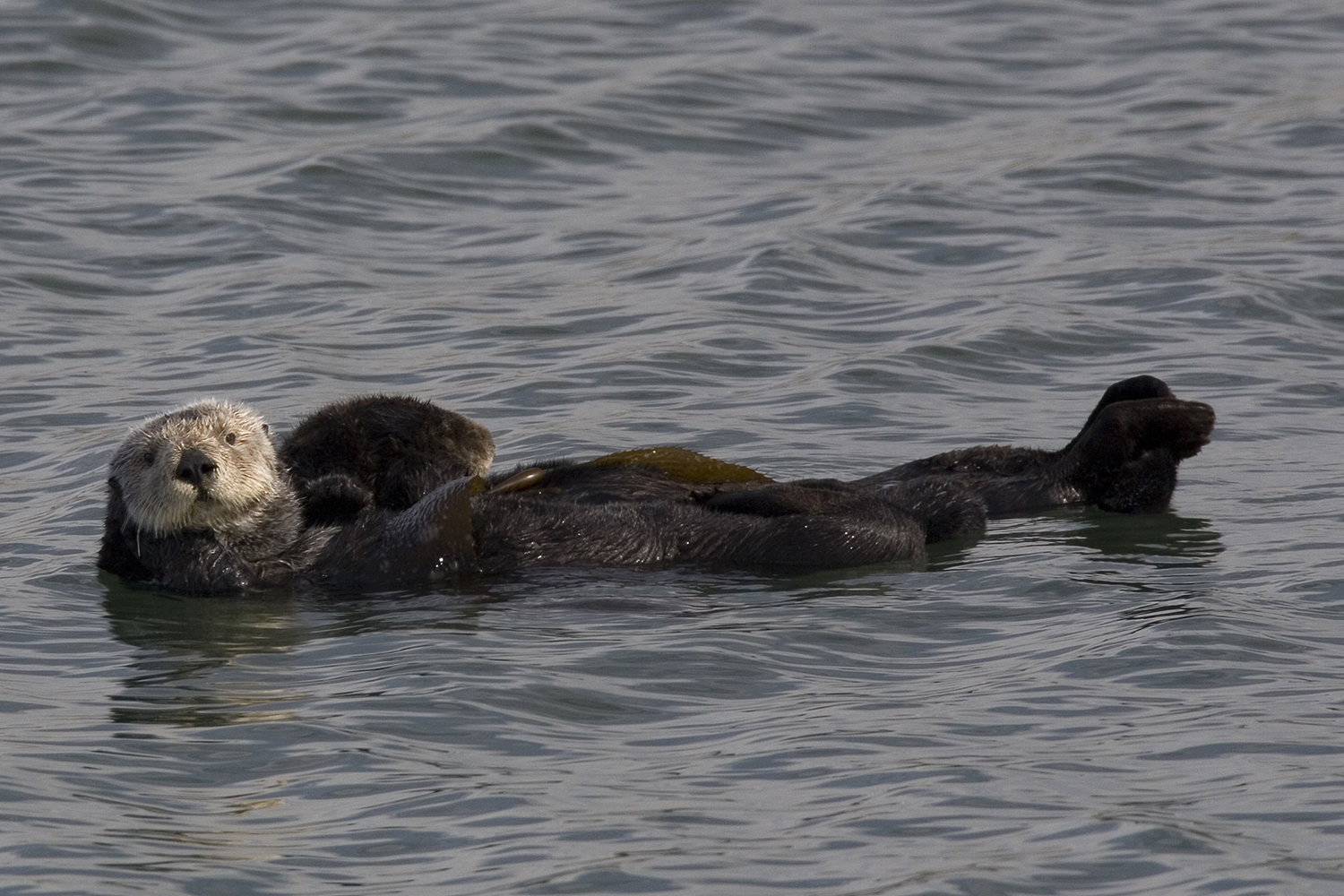

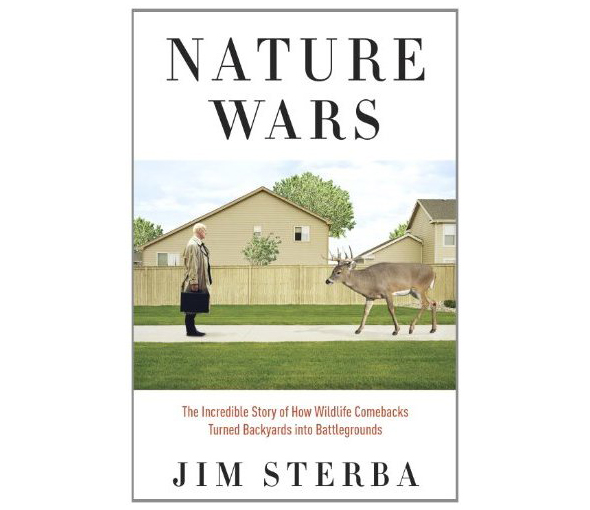
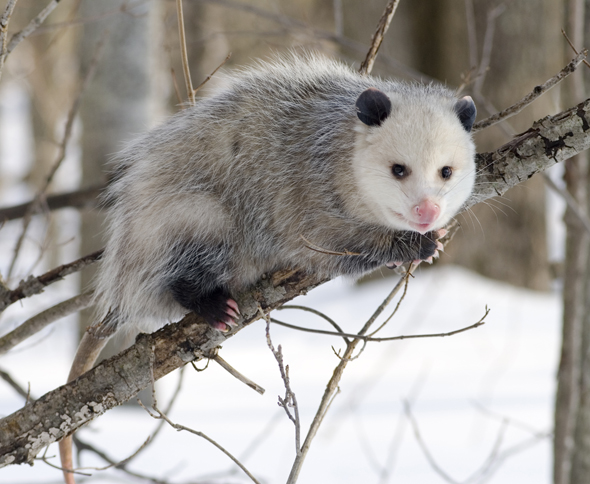 North American Opossum with winter coat. Photo courtesy of
North American Opossum with winter coat. Photo courtesy of 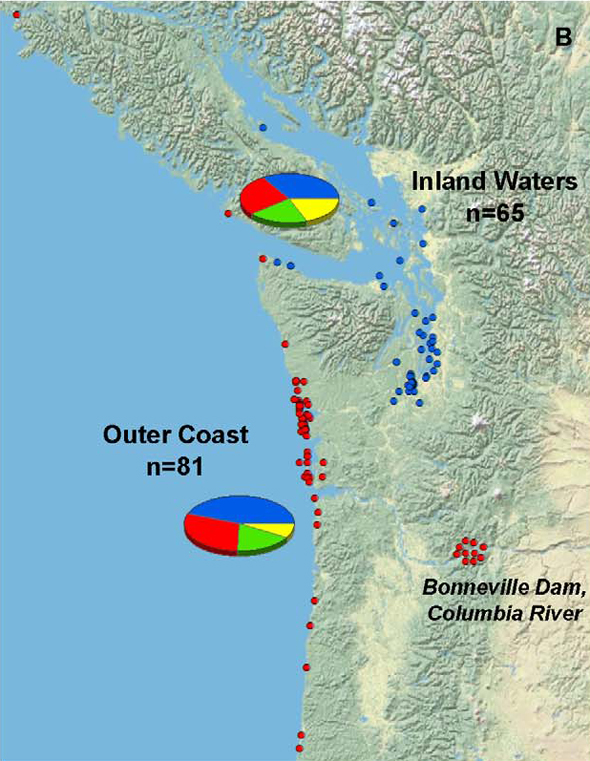
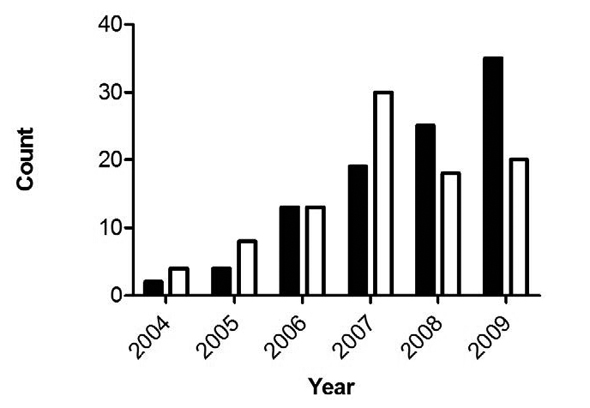
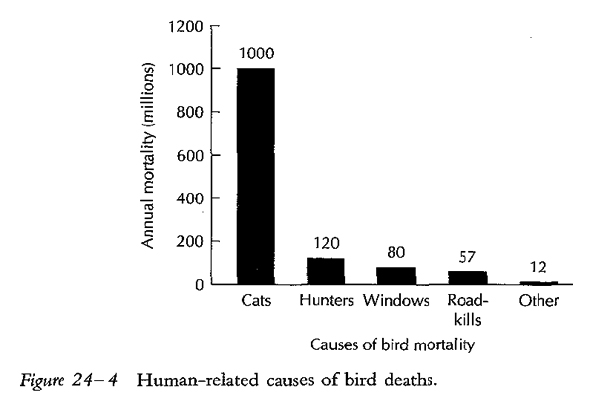
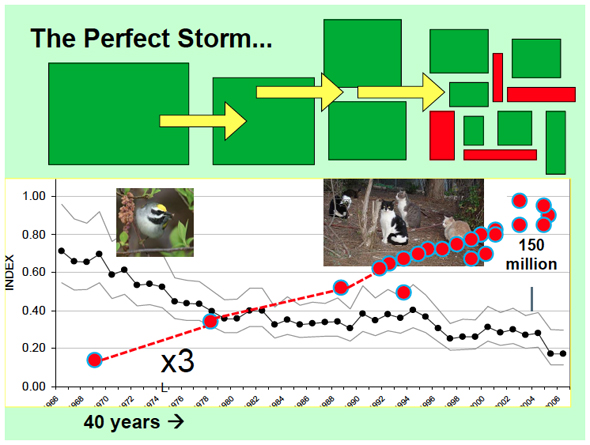
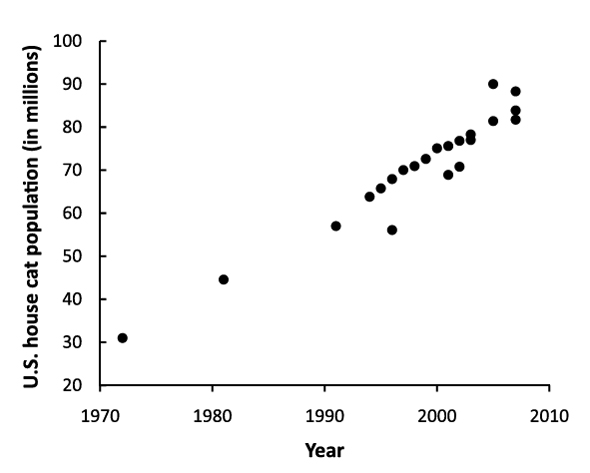

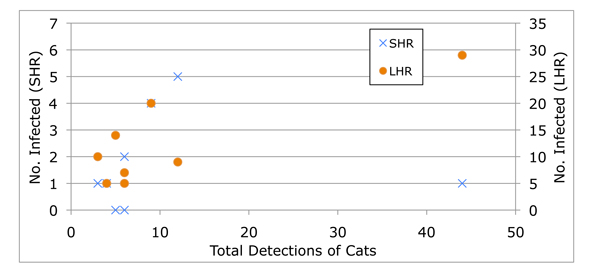
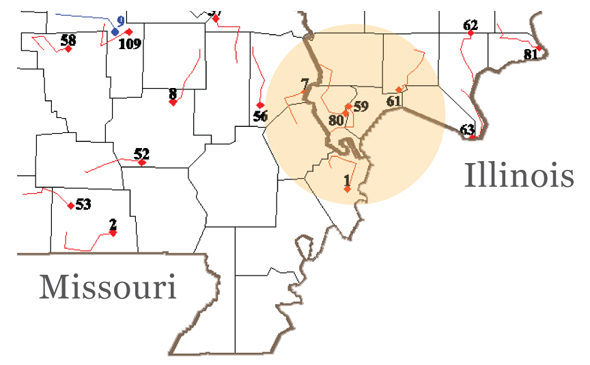
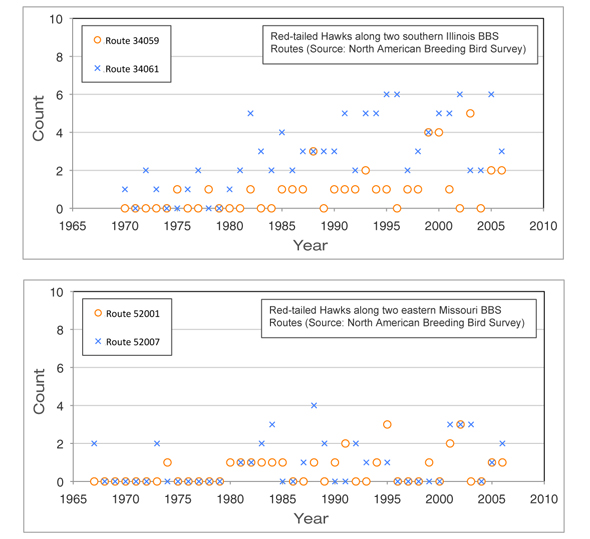 BBS Data: Red-tailed Hawks for two Illinois and two Missouri routes (adapted from
BBS Data: Red-tailed Hawks for two Illinois and two Missouri routes (adapted from 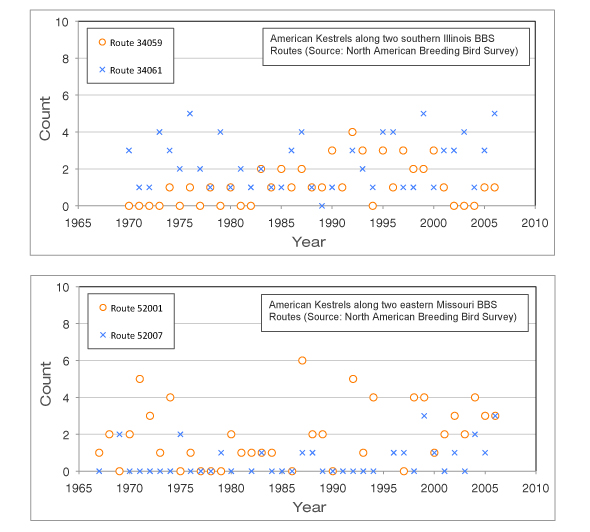 BBS Data: American Kestrels for two Illinois and two Missouri routes (adapted from
BBS Data: American Kestrels for two Illinois and two Missouri routes (adapted from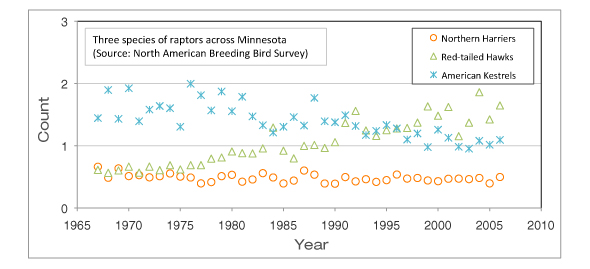 BBS Data: Three raptor species across Minnesota (adapted from
BBS Data: Three raptor species across Minnesota (adapted from